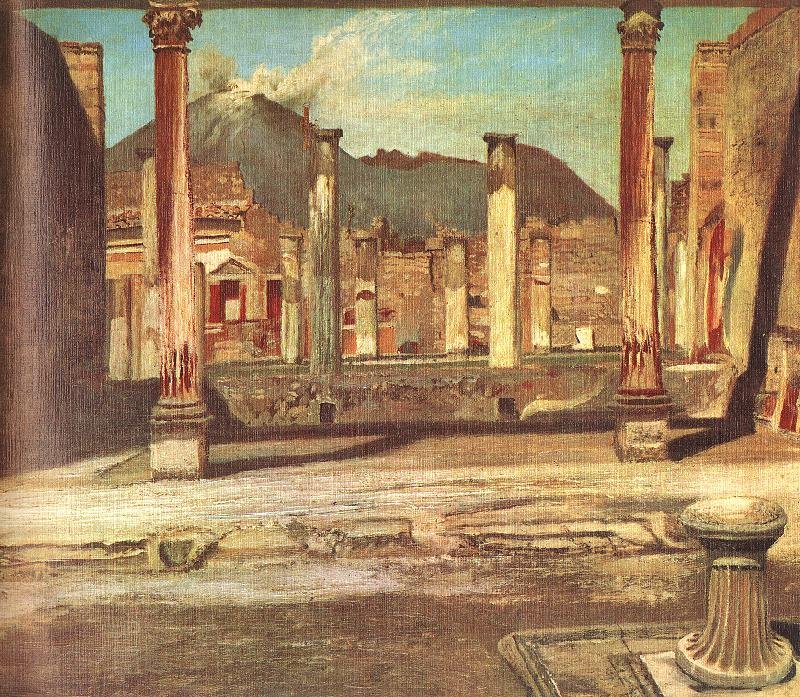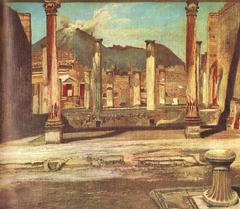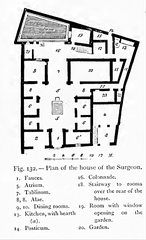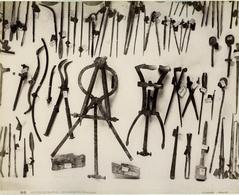
House of the Surgeon, Pompeii: Visiting Hours, Tickets, and Historical Significance
Date: 15/06/2025
Introduction
The House of the Surgeon (Casa del Chirurgo) stands as one of Pompeii’s most remarkable and historically significant sites. Renowned for its early Roman architecture and the extraordinary cache of ancient surgical instruments discovered within, it offers a rare window into both domestic life and medical practice in antiquity. This comprehensive guide covers the site’s history, architectural features, cultural importance, practical visitor information, travel tips, and answers to frequently asked questions, ensuring you make the most of your visit to this iconic Pompeii landmark.
Historical Background
Origins and Early Development
Located at Regio VI, Insula 1, Entrance 10, the House of the Surgeon is one of the oldest private residences in Pompeii, with origins tracing back to the 3rd century BCE (Pompeii in Pictures). The house’s archaic construction—predating much of Imperial Pompeii—offers crucial insights into the evolution of Roman domestic spaces and urban development.
The modern name of the house derives from the discovery of a remarkable set of surgical instruments during 18th-century excavations (Pompei Online). These instruments, including scalpels, forceps, and probes, suggest the residence belonged to a physician who may have served both human and animal patients, given its proximity to the Herculaneum Gate and nearby stables.
Architectural Features and Layout
The House of the Surgeon is an exemplary early domus, featuring a central atrium with an impluvium (rainwater basin), cubicula (bedrooms), a tablinum (reception room), and a modest hortus (garden). Its robust opus quadratum construction with large Sarno limestone blocks is a testament to its antiquity and the prestige of its original inhabitants (History and Archaeology Online; Madain Project).
Sparse yet significant wall paintings and mosaics, such as the depiction of a young woman painting a herm of Dionysus, reflect the tastes and social standing of the owner. The house’s layout, including the arrangement of private and public spaces, contrasts with more elaborate later villas, emphasizing function and status in early Pompeian society.
Medical Practice in Pompeii
The discovery of more than 40 surgical tools at the site is among the most significant archaeological contributions to our understanding of Roman medicine. These tools, crafted from bronze and iron, include instruments for both surgery and veterinary care (Pompei Online). Their sophistication demonstrates the advanced medical knowledge in Pompeii, with evidence suggesting procedures such as caesarean sections, hernia repairs, and trepanation were performed. The presence of pharmaceutical jars and chemical residues further indicates the preparation of medicines on-site.
Socio-Economic and Cultural Context
Situated along the Via Consolare, one of Pompeii’s main roads, the house was well-positioned to serve a diverse clientele, including travelers and animal handlers. The integration of living quarters and a professional workspace exemplifies the Roman tradition of home-based practice. Investments in water infrastructure and decorative elements reveal a family of considerable means and social ambition (Pompei Online).
Excavation and Preservation
First excavated in 1770, the House of the Surgeon has been the focus of ongoing conservation efforts. Documentation through photography and advanced technologies like 3D scanning has helped preserve its mosaics, wall paintings, and fragile architecture (Pompeii in Pictures). Evidence of post-62 CE earthquake repairs highlights the house’s long and dynamic history.
The House of the Surgeon in Pompeii’s Medical Landscape
Other Pompeian residences, such as the House of the Gladiator Physician, have also yielded medical artifacts, but the House of the Surgeon is exceptional for the variety and quality of instruments discovered. This reflects a broader, sophisticated healthcare network in ancient Pompeii (Pompei Online).
Visiting the House of the Surgeon: Practical Information
Location and Access
The House of the Surgeon is located within Regio VI of the Pompeii Archaeological Park. The most convenient entrance is Porta Marina, a short walk from the site. Signage and maps are available at entrances to assist visitors (The Roman Guy).
Visiting Hours
- April 1 – October 31: 9:00 AM – 7:00 PM (last entry at 5:30 PM)
- November 1 – March 31: 9:00 AM – 5:00 PM (last entry at 3:30 PM)
- Closed January 1, May 1, and December 25 (Pompeii Sites)
Always check the official website for the latest updates on hours and any temporary closures.
Tickets and Admission
- Standard Adult Ticket: €22
- Reduced Ticket (EU citizens 18–25): €2
- Free Admission: Under 18s (ID required)
- First Sunday of Each Month: Free entry
Tickets include access to the House of the Surgeon and all open areas of Pompeii. Online booking is strongly recommended to avoid queues (Italy Sights).
Accessibility
Pompeii’s ancient streets and houses present some accessibility challenges, with uneven paving stones and steps. The House of the Surgeon is not fully accessible for those with mobility impairments, but some routes are manageable. Comfortable walking shoes are essential (Krista the Explorer). Small dogs are allowed if leashed and carried indoors, but be cautious of wild dogs in quieter areas.
Guided Tours and Audio Guides
Guided tours led by archaeologists or expert historians are available and highly recommended for deeper insight. Audio guides can be rented at the entrance or accessed through mobile apps like Audiala, which provides interactive maps and commentary.
Travel Tips
- Bag Policy: Only small bags or backpacks allowed; pack light.
- Water and Snacks: Limited options inside the park—bring your own.
- Sun Protection: Use sunscreen, hats, and sunglasses.
- Weather: Dress in layers.
- Duration: Allocate 3–4 hours for Pompeii; 20–30 minutes for the House of the Surgeon.
- Best Times to Visit: Early mornings or late afternoons for cooler temperatures and fewer crowds.
- Photography: Non-flash photography is allowed; respect barriers.
What to Expect at the House of the Surgeon
The house features a partially roofed domus with well-preserved Roman paving, mosaics, and traces of wall paintings. Informative panels and reconstructions bring the story of Pompeii’s early medical practice to life. Some areas are restricted to protect fragile remains, but the overall layout—including the central atrium, bedrooms, and tablinum—offers a vivid sense of ancient domestic and professional life (Trek Zone).
Nearby Attractions
Enhance your visit by exploring these nearby highlights:
- House of the Faun: Known for its mosaics, 4 minutes away.
- Temple of Jupiter: Central religious site, 7 minutes away.
- Suburban Baths: Well-preserved, 6 minutes away.
- Temple of Isis: Early-excavated, 10 minutes away (Trek Zone).
Ticketing and Annual Passes
- Online Booking: Recommended; daily visitor numbers are capped at 20,000 (Pompeii Sites).
- Annual Pass: The MyPompeii card offers unlimited access for €35 (€8 for EU citizens under 25), valid at all park sites.
Additional Services
- Audio Guides: Available at entrances for a small fee.
- Restrooms: Found near main entrances and throughout the park.
- Shuttle Service: The Pompeii Artebus connects different areas but is not wheelchair accessible (Pompeii Sites).
Responsible Tourism
As a UNESCO World Heritage Site, Pompeii requires visitors to respect preservation guidelines. Avoid littering and supervise children closely due to uneven terrain and open ruins (Jen on the Run).
Visuals and Media
- View high-quality images and virtual tours of the House of the Surgeon on official Pompeii tourism sites.
- Look for visuals with alt tags like “House of the Surgeon Pompeii exterior” and “Ancient Roman surgical tools at Pompeii House of the Surgeon.”
Frequently Asked Questions (FAQ)
Q: What are the House of the Surgeon visiting hours?
A: The site follows Pompeii Archaeological Park’s seasonal hours: 9:00 AM to 7:00 PM (April–October), 9:00 AM to 5:00 PM (November–March).
Q: Are tickets required?
A: Yes, entry is included in the general Pompeii ticket. Online booking is recommended.
Q: Is the House of the Surgeon accessible for visitors with disabilities?
A: Accessibility is limited due to ancient paving and steps.
Q: Are guided tours available?
A: Yes, guided tours and audio guides are available and recommended.
Q: Can I bring my dog?
A: Small dogs are allowed if leashed and carried indoors.
Q: Are the original medical artifacts on display?
A: The original surgical instruments are held in the Naples Archaeological Museum; replicas and information panels are available on-site.
Summary and Encouragement to Visit
The House of the Surgeon remains a cornerstone of Pompeii’s rich urban and social history, uniquely illuminating the intersection of early Roman domestic life and sophisticated ancient medicine. With its well-preserved architecture, compelling artifacts, and accessible location, it is a must-see for anyone interested in archaeology, history, or the origins of medical science. Plan your visit by checking current opening times and ticket options, and enrich your experience with guided tours or digital resources.
By embracing responsible tourism and making use of available multimedia tools, visitors can fully appreciate the enduring legacy of the House of the Surgeon and its place within ancient Rome’s world. For further updates, immersive tours, and expert commentary, download the Audiala app and follow official Pompeii channels.
Sources and Further Reading
- Visiting the House of the Surgeon in Pompeii: History, Tickets, and Tips (Pompeii in Pictures; Pompei Online)
- Visiting the House of the Surgeon in Pompeii: Hours, Tickets, and Historical Insights (History and Archaeology Online; Madain Project; Audiala)
- House of the Surgeon in Pompeii: Visiting Hours, Tickets, and Architectural Highlights (Wikipedia; Interactive Archaeology; mariamilani.com)
- House of the Surgeon Visiting Hours, Tickets & Visitor Guide to Pompeii Historical Sites (The Roman Guy; Pompeii Sites; Krista the Explorer; Trek Zone; Italy Sights)
- Jen on the Run – 5 Tips for Visiting Pompeii



































































